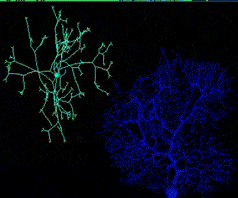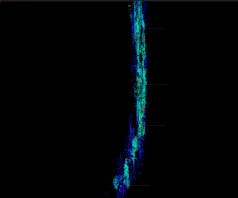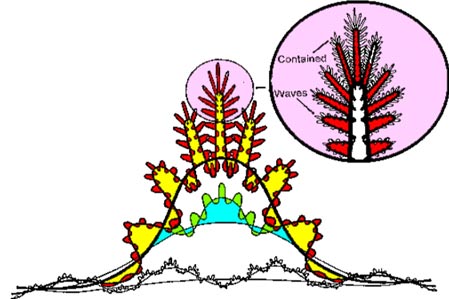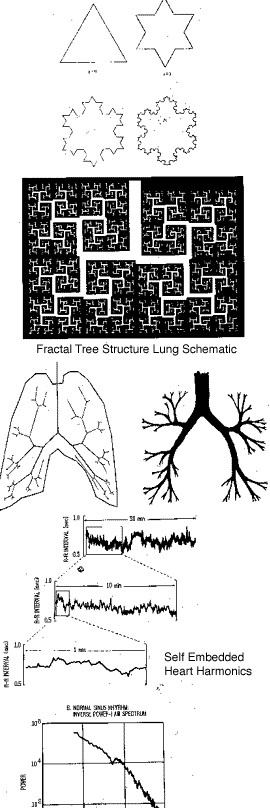
from Dan Winter, 12/26/2000 , url: ../tunnelling , other articles : ../sitemap.html
Since Acceleration and Gravity are identical (Einstein) - then if Winter is right that Acceleration and Compression are identical - Gravity must be occassioned among waves in general WHEN COMPRESSION IS OPTIMIZED - Which is mathematically perfected by fractal nesting based on Phi / Golden Ratio. Which means in summary, that Golden Ratio electrical nesting (capacitors arranged in the symmetry of PHI - ../grail.html , / stellated like ../predictions ) should CREATE measureable gravity from charge alone. This would prove the principle of why we find the moment of Golden Ratio harmonics in the Heart frequency signature - the moment of bliss - turns the ( imploding & compassioned ) heart into a gravity engine. Literally, this makes the self organizing centering force which enables our children to embed themselves into longer waves, like our SUN and eventually steer stars. This is why the first step to steering a tornado - or your loved one - is to FEEL into them .. This is the skill to turn inside out in such a way as to suck embed yourself into their center of (recursion) gravity. When you feel their center, better than they feel it themselves - we call that LOVE. This is why embedding feels like falling.
Successful fractality = perfect embedding, which is mathematically optimized by Phi - Golden Ratio.
Applying the notion that Fractal or Harmonic Inclusiveness in Heart Rate Music (HRV) = Biological Immortality ( ../dardik ) - with it's implication that heart embedability = compassion , we get the idea that sustainability for ecosystems must follow the same rule. Collectively our option is to get fractal or die. The practical meaning of this what we learn from the heart, tells us WHY sustaining bliss inside the EKG requires sustaining a fractal rose pattern in our back yard and planet magnetics. (In other words, a bliss ninny is just that: a ninny, out of the context of perfect context.. Extended family has the same meaning for magnetic lines feng shui, as it does for why it takes a community to raise a child.) *
extending conversations begun at: ../hrv , ../embedability , ../collapse , ../selfsimilarity
Compare the physics notion of tunnelling to
.. 'doczi spin' - See how phi harmonics naturally 'bring things
to a HEAD'- Where waves converge in Phi Ratio, they get launched
literally thru the speed of light - compression thru Planck Length
- TUNNEL
quoting from 'Fractals in Cardiology' inset below, 'The His-Purkinje network, a tree-like structure which rapidly (fractally?) transmits the electrical impulses from the atria to the ventricles.'... (end quote)
IS THIS HOW THE PERFECT BUTTERFLY EFFECT - GETS IT'S WINGS? By learning the geometry of perfect distribution - becoming infinitely shareable..
When the tree structure of this burning bush, learns to become fractal - on PHIre with compassion - does that (PHYlotactic ) connectivity become a black hole, faster than light, and in-PHI-knit?
After An Election in Effigy - Have We Found a Burning Bush?
Perfect Branch on Phire in the Heart! (Self Similar - Fibres of Perkinjole Where the Heart Catches PHIre)

Burning Bush... May Mean Something Non-Presidential AND More Than Biblical Here..
Cold Blue Maxin Light of A Phire That Does Not Consume.. Vril... Is That Your Heart Burning?
Is the Fractal Branching Tree Structure of the Notably Self Similar Fibres of Perkinjole Where the Heart Catches PHIre...

Black Holes to Blackboards:
God Divided by Zero
Down, up, and through the funnel. An embedding
diagram is generally a good representation of a black hole's warping
of nearby
space-time. But such 2-dimensional illustrations can also cause
conceptual problems.
ARE BLACK HOLE Worms into Perfect Compression
- The Spin Path to GOD / Zero Point?- Where Many Paths and Errands
Meet?
And have they figured out that DNA needing to braid into self embedding (self-similarity in fold with in fold kneading.. ) may be a superluminal mechanism of ensoulment / superconductivity and super compression - BEFORE THEY HACK OUT THE 'JUNK' -FRACTAL- DNA.. (read about gene splicers cost us our souls because they dont know what embedding does to DNA field effects at ../magneticx ). Below exerpted from: DNA Junk Noise is Fractal / DNA sequences show fractal correlations
"In every case, they found that noncoding
regions followed the Zipf relation more closely than did coding
regions, suggesting that junk DNA follows the structure of languages.
'We didn't expect the coding DNA to obey Zipf," Stanley notes.
'A code literal one if by land, two if by sea."You can't
have any mistakes in a code. * Language, in contrast, is a statistical,
structured system with built-in redundancies A few mumbled words
or scattered typos usually do not render a sentence incomprehensible.
In fact, the workers tested this notion of repetition by applying
a second analysis, this time from information theorist Claude
E Shanon who in the 1950s quantified
redundancies in languages. They found that junk DNA contains three
to four times the redundancies of coding segments. Because of
the statistical nature of the results, the researchers admit their
findings are unlikely to help biologists identify functional aspects
of junk DNA. Rather the work may indicate something about efficient
information storage. "There has to be some sort of hierarchial
arrangement of the information to allow one to use it in an efficient
fashion and to have some adaptability and flexibility,' Goldberger
observes."
end quote. comment by Dan Winter: Efficient information storage IS FRACTAL DATA COMPRESSION - so therefore children when are we going to STOP calling the non-coding regions in DNA JUNK!!!!
* note also exquisite detail on this idea of (fractal?) embedding in Language Structure implicate in the book: "Grammatical Man: Information Entropy, Language and Life" by Jeremy Campbell. - he calls this "context richness" - or "context dependancy".
Compare this to related: ../selfsimilarity , ../collapse , ../dardik ,
below (Clearly inspired by the work of Dr. Ary Goldberger on the Self Similar Fractality of the Heart's Electrification)
reprinted from: http://www.sewanee.edu/Phy_Students/smithjs0/Fractals_in_Cardiology.html
"Yes, for all these years, we have been living with fractal arteries, not far from fractal river systems, draining fractal mountainscapes under fractal clouds, toward fractal coastlines." M. Schroeder (Iannaccone 249)
Introduction A snowflake in Vermont, the coastline of Italy, the Nile River: all of these share a characteristic that is very common in nature(Iannaccone 5). They all have geometric complexity(Iannaccone 5). In each of these fractal objects self-similarity exist(Iannaccone 5). "Self-similarity implies that looking at one part of the object offers the same information as looking at another part of the object"(Iannaccone 5). In biological systems fractal geometry abounds in many was comparable to that seen in physical systems. Self-similarity appears to be a property of the healthy function of the human cardiovascular system(Innaccone 250). This self-similarity appears at both the microscopic and macroscopic levels of observation(Iannaccone 250). Fractal Geometry of the Heart A number of cardiopulmonary structures have a fractal-like appearance(Iannaccone 251). Examples of Fractals in Cardiovascular Physiology(Iannaccone 251). I. Structural A. Vascular: arterial and venous tress B. Muscular:
C. Electrical: His-Purkinje network D. Connective tissue: chordae tendineae; aortic valve leaflets II. Dynamical (1/f spectra) A. Regulation of healthy heartbeat fluctuations B. Regulation of healthy beat-to-beat blood pressure fluctuations
Examples of self-similar architectures include the arterial and venous trees and the branching of certain cardiac muscle bundles, as well as the ramifying tracheo-bronchial tree and the His-Purkinje network(Iannaccone 251).
Image 1 Cast of the human coronary artery tree. This rich, redundant network supplies blood to the heart muscle with enormous efficiency and reserve.(Courtesy of Ciba-Geigy)
Image 2 The pectinate muscle of the canine artium shows a complex branching pattern.(Adapted from Goldberg, A.L., and West, B.J., Yale J, Biol. Med., 60, 421, 1987.) The His-Purkinje network provides a highly efficient mechanism for rapidly distributing the electrical impulse(Iannaccone 251).
Image 3 Schematic diagram of the His-Purkinje network, a tree-like structure which rapidly transmits the electrical impulses form the atria to the ventricles.(Adapted form Goldberger, A.L., Bhargava, V., West, B.J., and Mandell, A.J., Biophys. J., 48, 525, 1985.) All the self-similar cardiopulmonary architecture serves a common physiologic function: rapid and efficient transport over a complex, spatially distributed system(Iannaccone 251). In the case of the electrical conduction system, the quality being transported is the electrical stimulus that regulates the timing of cardiac contraction(Iannaccone 251). In the case of the vasculature, fractal branching provide a rich network for distribution of oxygen and nutrients and for the collection of carbon dioxide and other waste products of metabolism(Iannaccone 251). The fractal tracheo-bronchial tree provides an enormous surface area for exchange of gases(Iannaccone 251). The branching pattern of certain muscle bundles within the heart is also fractal-like(Iannaccone 251). The overall organization of muscle tissue can be viewed as a fractal hierarchy of bundles within bundles within bundles.
HUMAN HEARTBEAT DYNAMICS An aspect of the fractal concept was the recognition
that it could be applied not just to irregular geometric forms
that lack a characteristic length scale, but also to complex
processes that lack a single scale of time(Iannaccone 251). Fractal
process generate fluctuations on multiple time scales, such variations
are self similar(Iannaccone 251). The self-similarity of the
fractal process can be seen by plotting the time series in question
at different "magnifications"(Iannaccone 252). Figure 5 The normal heartbeat fluctuates in an apparently irregular fashion, these fluctuations, when examines at different temporal resolutions, show a similar type of "rough" surface or landscape.(Adapted from Goldberger, A.L., Rigney D. R., and West, B.J., Sci. Am., 262, 42, 1990.) Figure 5 show the time series of the heartbeat from a healthy person plotted on three different scales(Iannaccone 252). All three graphs show that the normal heartbeat has an irregular appearance. The difference, however, on each time scale is not noticeable. "The roughness of the "time-scape" (analogous to a fractal landscape) appears to have a self-similar property(Iannaccone 252). The normal activity of the heart has been describes as "regular sinus rythm," but the intervals normally fluctuate in a complex sporadic manner(Iannaccone 252). Conclusion The consecpt of fractals may be useful in understanding spatial and temporal "structure" of the human heart. Fractal analysis can be used to examine time serices of the heart. Studying the different fractal structure of time series it may be possible to identify at-risk patients. References Iannaccone, P. Philip and Mustafa Khokha. Fractal Geometry in Biological Systems An Analytical Approach . CRC Press, New York, 1996. |

|
exerpted from:THE MUSIC OF THE SPHERES - The Emerging Paradigm Shift In Science http://www.google.com/search?q=cache:www.federal.com/jul10-00/Spheres+"Music+of+the+Spheres"+AND+goldberger&hl=en
... that mysterious number Phi, which the The influence of Phi can also be found in the plant world,
in the The reason why this relationship occurs so frequently in nature X = 1 + 1/X This merely describes a property of the Golden Ratio: divide
1 by Congratulations, you have just solved a problem in numerical X = 1 + 1/X the result was "fed back" into the equation. In
mathematics this Feedback is thought to be one of the basic mechanisms whereby A B the ratio of A to B is equal to the ratio of 0.618034 to Why do the lengths of the bronchial tubes scale down in this |

